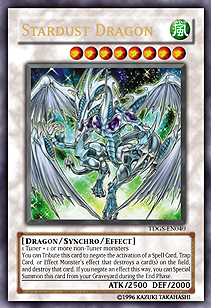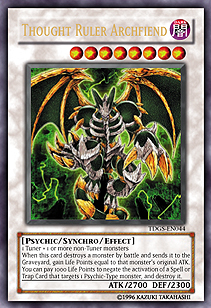 has long been my personal favorite Synchro monster. The ability to negate destruction once per turn, destroy the card that attempted to cause said destruction, and pack 2500 ATK was certainly enough to crush Gladiator Beasts. But since TeleDAD duelists have faced mostly Lightsworn or mirror matches in major tournaments, Stardust has seen a dramatic decrease in play by the vast majority of competitors. The reason is cards like Phoenix Wing Wind Blast, Goyo Guardian, and Thought Ruler Archfiend. However, based on the coverage of Shonen Jump Championship Chicago, it seems the tournament may have been a coming out for Stardust Dragon.
has long been my personal favorite Synchro monster. The ability to negate destruction once per turn, destroy the card that attempted to cause said destruction, and pack 2500 ATK was certainly enough to crush Gladiator Beasts. But since TeleDAD duelists have faced mostly Lightsworn or mirror matches in major tournaments, Stardust has seen a dramatic decrease in play by the vast majority of competitors. The reason is cards like Phoenix Wing Wind Blast, Goyo Guardian, and Thought Ruler Archfiend. However, based on the coverage of Shonen Jump Championship Chicago, it seems the tournament may have been a coming out for Stardust Dragon.
What many top players are finding these days is that setups with Stardust Dragon are a lot more concrete than alternatives if you build your deck properly. The addition of Necro Gardna and Dimensional Prison to the more successful builds is an example of just that. 2500 ATK is a lot, but your opponent should be able to produce monsters with higher ATK. Stardust stops virtually every form of out-of-battle destruction, but when it comes down to hand-to-hand combat with bigger guys Stardust is a goner. That’s why you need to protect it with cards like Necro Gardna or Prison.
What many people don’t realize is why this is such a beneficial thing to do: Stardust Dragon can let you play around a lot of different cards, forcing your opponent into a game state he or she may not be able to control. Many players claim Stardust is too easy to defeat, and that taking care of it is as simple as playing Wind Blast. However I believe that with any other Synchro you’d be in just as tight a spot.
Let’s say you have Dimensional Prison set and are deciding between Stardust or Thought Ruler Archfiend. Many players would tell you to Synchro summon Thought Ruler due to fear of Wind Blast. But if you choose to summon the Archfiend, your opponent is just going to allow your attack that turn, and flip Wind Blast during the end phase to spin away your support card instead. Dimensional Prison will be spun to the top of your deck and your opponent will Synchro summon in total safety. Chances are good that Goyo Guardian will be a viable option for your opponent, and suddenly you’re staring down Goyo and Thought Ruler knowing you’re about to draw Dimensional Prison. That’s no fun.
Now replace Thought Ruler with Stardust Dragon. Your opponent could make the same play, but chances are he or she won’t. If your opponent spins your back-row card and takes Stardust with Goyo, you can simply set the Prison again to take care of Goyo, and ideally get back your Stardust either with your own Goyo or some destruction effect that would threaten the opposing Guardian. In the latter case your opponent will probably trigger Stardust to keep Goyo on the field, giving it back to you and hoping to take it with his or her Goyo again next turn. Then you stop the opponent with Prison.
 The best part about this whole thing? The Prison is protected by Stardust Dragon from the beginning! Heavy Storm and Mystical Space Typhoon aren’t outs to your setup because Stardust would just negate them and Prison would take care of the attacker anyway. Not even Thought Ruler Archfiend can get by Stardust Dragon and Dimensional Prison. Thought Ruler attempts to destroy as well as negate, so Stardust Dragon can instead negate and destroy Thought Ruler in response.
The best part about this whole thing? The Prison is protected by Stardust Dragon from the beginning! Heavy Storm and Mystical Space Typhoon aren’t outs to your setup because Stardust would just negate them and Prison would take care of the attacker anyway. Not even Thought Ruler Archfiend can get by Stardust Dragon and Dimensional Prison. Thought Ruler attempts to destroy as well as negate, so Stardust Dragon can instead negate and destroy Thought Ruler in response.
Much of the problem becomes how to protect Stardust Dragon from multiple card combos. For example, if you set up with Stardust Dragon and Dimensional Prison and I can special summon my own Stardust Dragon and Dark Armed Dragon, you’ll be trumped. Dark Armed will destroy the Prison and if you try to use Stardust to negate it I’ll use my own Stardust to negate yours.
The answer is more copies of Stardust Dragon! Double the fun and now you’ve got two Stardust cards protecting each other. Think of how two copies of Marauding Captain prevented each other from being attacked. Now give them 2500 ATK each, along with an ability that can prevent them from being destroyed. Pretty cool, huh? That’s going to take down even the most promising answers. Rarely does a player have two simple outs to Stardust Dragon like two copies of Phoenix Wing Wind Blast. Usually it’s something like Wind Blast backed up with Mirror Force, only one of which is effective against Stardust.
Finally I want to stress something else: the fact that Stardust Dragon does have weaknesses can be used as an asset rather than a liability. Stardust can’t be taken care of easily. It takes power cards like Dark Armed Dragon, Brain Control, or opposing Synchro summons to take it down. Even if you have to lose Stardust Dragon, bringing it out to force your opponent’s power cards into your Torrential Tribute can be a very good strategy. You’ll lose Stardust, but you would have lost any Synchro anyway, and with Stardust you protect the Torrential until it’s used. That opens you up to play another Stardust next turn, and this time it won’t be so easy to deal with because your opponent has already expended answers.
The most important thing to remember is that your opponent only starts with six cards. The rewards of protecting Stardust Dragon increase as your opponent’s total card count decreases. The chances of the opponent having an out to your Stardust become lower—and if you’re able to take care of that one out, you can freeze your opponent entirely. Cards like Solemn Judgment, Phoenix Wing Wind Blast, and Dimensional Prison that prevent your opponent from dealing with Stardust can also render Stardust virtually indestructible, which will eventually lead to you winning the game.
This is just another example of how playing two copies of Stardust can be so much better than one. If both players have six cards and you play Destiny Draw and Destiny Hero - Malicious to special summon Stardust Dragon, then use Krebons and Malicious to Synchro for Stardust, you’ve really only used one card. Destiny Draw and Malicious replaced themselves and the second Malicious was free from the deck. You effectively normal summoned Stardust Dragon and it cost you only one card’s worth of presence.
 From there, if your opponent uses Phoenix Wing Wind Blast to rid the field of your Stardust, that cost him or her two cards (Wind Blast and the card that was discarded). Now your opponent has four cards to your five. If you went first, you’ll have two more cards than your opponent once you draw for your turn. Simply use another Krebons for a second Stardust and now your opponent has only five cards after his or her draw: just five cards to deal with a Stardust and move toward winning the game. It’s going to be hard to do both.
From there, if your opponent uses Phoenix Wing Wind Blast to rid the field of your Stardust, that cost him or her two cards (Wind Blast and the card that was discarded). Now your opponent has four cards to your five. If you went first, you’ll have two more cards than your opponent once you draw for your turn. Simply use another Krebons for a second Stardust and now your opponent has only five cards after his or her draw: just five cards to deal with a Stardust and move toward winning the game. It’s going to be hard to do both.
It becomes especially difficult if—on the turn when you play your second Stardust—you first destroy some of the opponent’s cards. Let’s say he or she sets three cards and a monster after you summoned Stardust on your first turn. Next turn you draw and play Heavy Storm. The opponent chains Solemn Judgment to negate it, and then flips Phoenix Wing Wind Blast after the chain resolves to spin Stardust back. You summon Breaker the Magical Warrior and your opponent flips Crush Card Virus, sending Spirit Reaper to the graveyard to destroy your Breaker and your in-hand Dark Armed Dragon (you had a sick hand.).
Still, you play Emergency Teleport and special summon your last copy of Malicious to make another Stardust. Now your opponent only has two cards after his or her next draw, and chances are he or she can’t really take care of your Stardust. Even though you probably only have Stardust and one more card left, and you’re under Crush Card, you’re in the better position because you have Stardust. The cards that survived the Crush are spells and traps, meaning they can support your Dragon. I’ve always said I’ll take Stardust Dragon and Phoenix Wing Wind Blast against any two cards.
—Matt Peddle